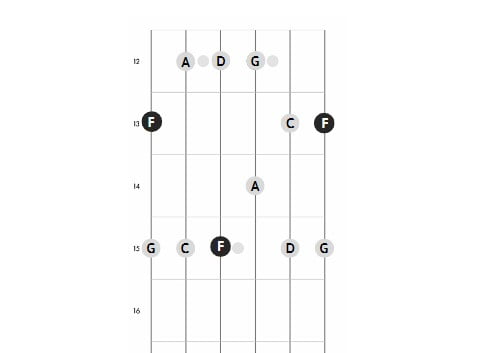How to Play The F Major Pentatonic Scale on Guitar
The F major pentatonic scale is an excellent starting point for guitarists looking to enhance their solo skills and expand their overall scale proficiency. This pentatonic scale is common in many popular music genres and can be heard in a variety of songs. Its versatile sound can produce a bright, punchy tone or a darker, more mysterious mood in a song.
You may recognize the F major pentatonic scale in many songs. For instance, you can hear it in "House of the Rising Sun" by The Animals for a bluesy, mystery-laden take. You can also pick out the F pentatonic scale in B.B. King's rendition of the blues standard "Come Rain or Come Shine," from blues-influenced rock to more traditional blues. Taylor Swift's 1989 album features several pop hits built around this five-note scale, including "All You Had to Do Wa Stay," "How You Get the Girl," and "Blank Space."
Regardless of your music preference, the F major pentatonic scale provides a fundamental template for lead guitarists to create catchy songs and expansive riffs. Like the C major scale, the F major pentatonic scale has no sharps or flats, making it easy to learn, remember, and commit to memory.
NOTES ON THE F MAJOR PENTATONIC SCALE
The F major scale is made up of just five of the notes from the Bb, C, D, E, F, G, and A scales. Specifically, it uses the 1st (F), 2nd (G), 3rd (A), 5th (C), and 6th (D) notes. When playing the F major pentatonic scale across the fretboard, you will repeat these five notes in higher or lower octaves. These notes are:
• F
• G
• A
• C
• D
The F major triad chord consists of the notes F, A, and C, which are also part of the F major pentatonic scale.
F MAJOR PENTATONIC SCALE POSITIONS
To play the F major pentatonic scale, there are various ways to do so. In this lesson, we will cover two methods: in the open position and in the 12th position. The open position begins on the 1st fret of the low E string, while the 12th position is played in a higher range, starting on the 13th fret of the low E string. By playing both positions, you can hear the difference in tone.
We will demonstrate how to play the F major pentatonic scale using charts that indicate where to place your fingers to play the scale. These diagrams represent your guitar's neck. Each dot on the diagrams represents a specific note on a particular fret and string. If you see a dot with a note above the string, you will play the string in the open position. The dark dots indicate the root note of the scale, which is F in this case.
Open position
To start playing the F major pentatonic scale, place your first (index) finger on the 1st fret of the low E string. Then, stretch your third (ring) finger to the 3rd fret of the same string. As you progress through the notes in this scale, you will see that your ring finger will play the third fret on every string except for the G (3rd) string.

12th position
To play the F major pentatonic scale in the 12th position, begin by placing your middle finger on the 13th fret of the low E string. From there, finger placement becomes a bit more complex than in the open position. Using your pinky, play the 15th fret of the same low E string, then add your index finger to the 12th fret of the A string. As you progress through this scale, each of your four fingers will play a note.
The 12th position is an excellent version of the F major pentatonic scale to help you familiarize yourself with the lower portion of your fretboard and matching notes. Additionally, it can help you develop greater finger dexterity.

F MAJOR PENTATONIC SCALE TABS
For guitarists who struggle with reading charts, tablature is a useful alternative for learning how to play. Since every guitarist has a unique learning style, the F major pentatonic scale can be played and learned in various ways. To provide a different approach, let's explore playing the same F major pentatonic scale positions using tabs. This alternative method may suit your learning style better than charts, or vice versa.
Open position
Let's begin playing the F major pentatonic scale with a tab, starting with the open position. Start on the low E string (the string closest to you if you're looking down at your guitar). To play the scale, fret the first note of the scale (F), which is located on the 1st fret of this string. The tab below shows which fret to play on each string.
Use your ring finger for the stretch from frets 1 to 3, and your middle finger for the shorter gap between frets 1 and 2 on the G string. Once you've successfully played this scale, try playing it in reverse order (descending).
12th position
To distinguish the difference in octaves and tones, let's play the 12th position using tablature. Start by fretting the first note in the scale (F) by placing your index finger on the 13th fret of the low E (6th) string (the thickest string and the one closest to you if you're looking down at your guitar). As you progress through the scale, this fret will act as a home base, but your designated finger will change to your middle finger once you reach the A (2nd) string. You'll play two notes on each string, moving across the fretboard.
After playing through the scale, try playing it again in reverse order (descending). Pay attention to the root note (F) as you play and notice how different it sounds one octave higher as your starting and finishing notes.
F MAJOR PENTATONIC SCALE EXERCISES
As with learning anything else in life, repetition is the best way to memorize and practice the F major pentatonic scale. Practice playing the scale in ascending and descending order, beginning with the root note of F, then playing G, A, C, D, and a higher F. You can use either the open or 12th position pattern to play these notes, then work your way back down the scale, starting with the higher F and descending to D, C, A, G, and the low F.
If you want to challenge yourself while learning pentatonic scales, try playing them in ascending and descending order using different picking styles. Experimenting with alternate picking, downpicking, and fingerstyle can help you understand how different styles alter the tone. It will also improve your finger dexterity and muscle memory.
If you're interested in learning more about pentatonic scales, chords, and musical theory, visit our Guitar tunio today








